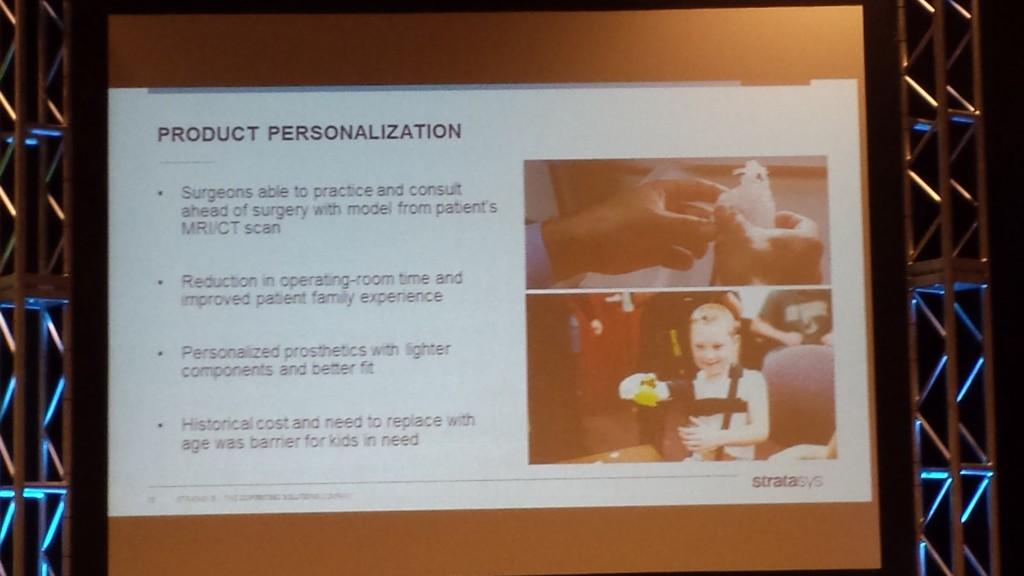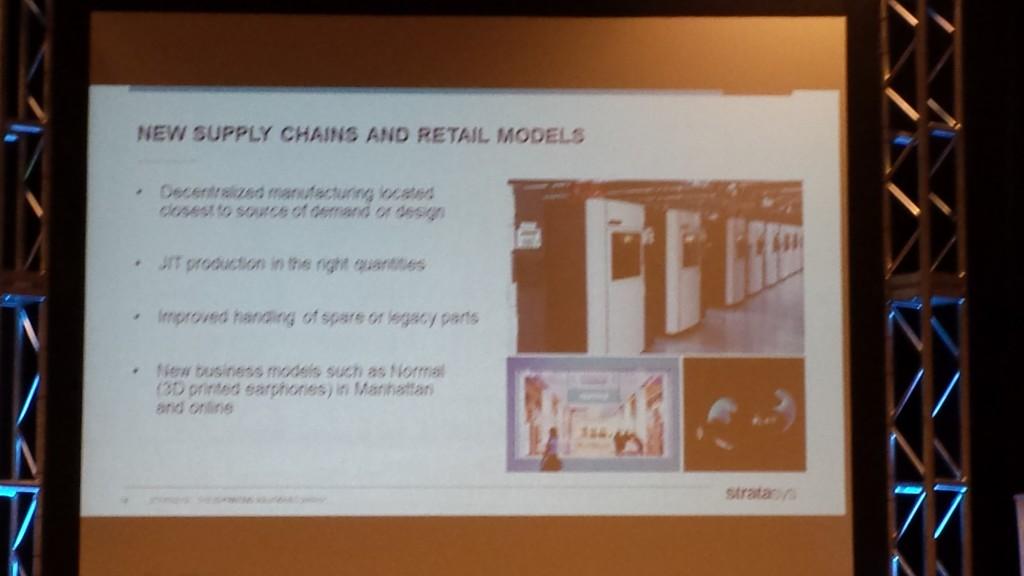 For my bachelor’s degree, I went to a small, liberal arts college in the rolling hills of southeastern Ohio. You might call the surroundings idyllic, as I went uphill to class (both ways, in the snow, as I’ll honestly tell my hypothetical grandchildren one day), attending small-group sessions in my English and theatre courses. My only big, lecture-style classes were for graduation requirements in math and astronomy, where I’d sit in the few large auditoriums on campus and take notes like a madwoman, trying to track every word from the professor’s mouth. I felt a little like that yesterday, listening to a keynote given by Stratasys‘ Rich Garrity, Vice President and General Manager, Vertical Solutions, at Inside 3D Printing Santa Clara, as I took pages of notes.
For my bachelor’s degree, I went to a small, liberal arts college in the rolling hills of southeastern Ohio. You might call the surroundings idyllic, as I went uphill to class (both ways, in the snow, as I’ll honestly tell my hypothetical grandchildren one day), attending small-group sessions in my English and theatre courses. My only big, lecture-style classes were for graduation requirements in math and astronomy, where I’d sit in the few large auditoriums on campus and take notes like a madwoman, trying to track every word from the professor’s mouth. I felt a little like that yesterday, listening to a keynote given by Stratasys‘ Rich Garrity, Vice President and General Manager, Vertical Solutions, at Inside 3D Printing Santa Clara, as I took pages of notes.
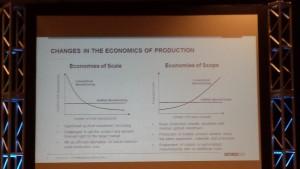 The keynote, “Meeting the Future with Additive Manufacturing,” covered all the promised bases of the description, touching on developments and aims in aerospace, automotive, and healthcare applications, among others. In just 45 minutes, Garrity moved smoothly and knowledgeably from topic to topic, prepared to present an incredible amount of information in a fairly compressed time–and by the end of his talk, I was certainly convinced that he was spot-on in one of his initial statements:
The keynote, “Meeting the Future with Additive Manufacturing,” covered all the promised bases of the description, touching on developments and aims in aerospace, automotive, and healthcare applications, among others. In just 45 minutes, Garrity moved smoothly and knowledgeably from topic to topic, prepared to present an incredible amount of information in a fairly compressed time–and by the end of his talk, I was certainly convinced that he was spot-on in one of his initial statements:
“Stratasys is not just about 3D printing.”
The Stratasys ecosystem has an incredible reach in the 3D world, bringing under the same umbrella everything from Thingiverse (which has reached more than one million unique downloads each month) to life-saving models of hearts for pediatric surgery. With 3D printing set out to become an ever-larger presence–Garrity noted that the Wohlers Report projections had gone up over just a couple years, initially projecting that 3D printing would constitute a $5 billion market by the end of the decade, but now looking closer to $21 billion at that time; and the McKinsey projection from 2013 that the total economic impact of 3D printing would be $100 billion to $200 billion by 2025–the world is truly taking notice of what this technology has to offer.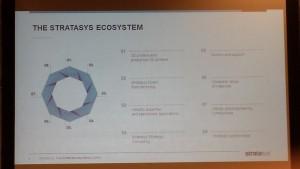
Garrity covered several main benefits of additive manufacturing, many of which are applicable for any end use, from industrial to desktop.
“The key word in additive manufacturing,” Garrity explained, “is flexibility. You can literally begin production virtually anywhere. It changes the economies of production.”
Among other noted key points were that designs that had previously required higher numbers of individually designed components could be streamlined. Garrity pointed to the winning design in the CubeSat Challenge as an example: this design took dozens of parts down to just two. Furthermore, product personalization is a feature of additive manufacturing, including for surgical models (a “growing, growing use case adoption”) and prosthetics (notably for children, and especially those in third world countries, for whom the low-cost prosthetics available via additive manufacturing methods are literally life-changing). The decentralization of the supply chain is an additional key feature–set to “alter the supply chain”–bringing production to areas based on customer demand.
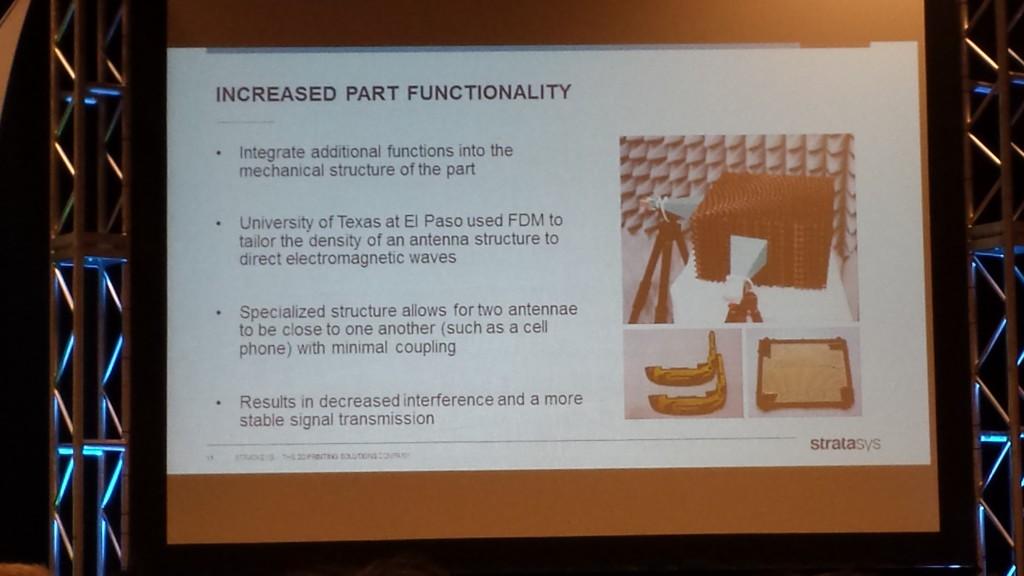 To highlight his points, Garrity pointed to customer use cases as proof-of-concept illustrations of the broad range of benefits possible via additive manufacturing. Among the cases presented were:
To highlight his points, Garrity pointed to customer use cases as proof-of-concept illustrations of the broad range of benefits possible via additive manufacturing. Among the cases presented were:
- Airbus
- Solaxis
- Unilever
- United Launch Alliance
- Nicklaus Children’s Hospital
 We’ve covered most of these companies’ participation in the additive manufacturing space before. Airbus, for its part, has made well-publicized use of 3D printing in commercial airplanes. Stratasys was on the ground in Canada to work with Solaxis, as Garrity played a short video depicting the uses of additive manufacturing in helping the company to improve working conditions. With 3D printing, workers are able to be happier and more productive, using ergonomically friendly, personalized tools on the line. Unilever benefits from additive manufacturing techniques through the creation of 3D printed injection molds, which shorten production time substantially. The United Launch Alliance cut down an impressive 57% on costs for a ducting system, slashing parts numbers from 140 individual components down to just 16 created via FDM process. Nicklaus Children’s Hospital was a case study we followed recently, in which a 5-year-old girl’s life was saved thanks in part to a customized 3D printed model of her heart’s unique anatomy.
We’ve covered most of these companies’ participation in the additive manufacturing space before. Airbus, for its part, has made well-publicized use of 3D printing in commercial airplanes. Stratasys was on the ground in Canada to work with Solaxis, as Garrity played a short video depicting the uses of additive manufacturing in helping the company to improve working conditions. With 3D printing, workers are able to be happier and more productive, using ergonomically friendly, personalized tools on the line. Unilever benefits from additive manufacturing techniques through the creation of 3D printed injection molds, which shorten production time substantially. The United Launch Alliance cut down an impressive 57% on costs for a ducting system, slashing parts numbers from 140 individual components down to just 16 created via FDM process. Nicklaus Children’s Hospital was a case study we followed recently, in which a 5-year-old girl’s life was saved thanks in part to a customized 3D printed model of her heart’s unique anatomy.
Garrity finished up by pointing to the enterprise impact of additive manufacturing. The picture wasn’t all peaches-and-cream, as he pointed out a substantial number of known barriers to entry that have prevented additive manufacturing from simply sweeping in and saving the day, as it were. Additive manufacturing isn’t a magical solution, but a developing tool. In overcoming these barriers, Garrity pointed to a couple major helping factors: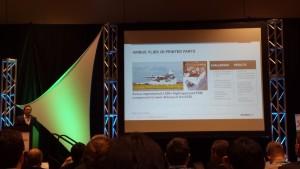
- Companies are proactive in the development and use of additive manufacturing throughout their supply chains
- Younger generations have had experience with high-tech learning for most of their lives; STEM education is benefiting the workforce now as recent graduates bring their learned skills to the table
- Better, automated tools
- The latest in high-tech additive manufacturing equipment is working with traditional machinery
I’m looking forward to having a second chance to hear Garrity speak today, as he joins Terry Wohlers and The UPS Store’s Daniel Remba in the much-anticipated Ask the Experts panel.
Subscribe to Our Email Newsletter
Stay up-to-date on all the latest news from the 3D printing industry and receive information and offers from third party vendors.
You May Also Like
Gorilla Sports GE’s First 3D Printed Titanium Cast
How do you help a gorilla with a broken arm? Sounds like the start of a bad joke a zookeeper might tell, but it’s an actual dilemma recently faced by...
Nylon 3D Printed Parts Made More Functional with Coatings & Colors
Parts 3D printed from polyamide (PA, Nylon) 12 using powder bed fusion (PBF) are a mainstay in the additive manufacturing (AM) industry. While post-finishing processes have improved the porosity of...
$25M to Back Sintavia’s Largest Expansion of Metal 3D Printing Capacity Since 2019
Sintavia, the digital manufacturing company specializing in mission-critical parts for strategic sectors, announced a $25 million investment to increase its production capacity, the largest expansion to its operations since 2019....
Velo3D Initiates Public Offering in a Bid to Strengthen Financial Foundations and Drive Future Growth
Velo3D (NYSE: VLD) has been among a number of publicly traded 3D printing firms that have attempted to weather the current macroeconomic climate. After posting a challenging financial report for 2023,...



